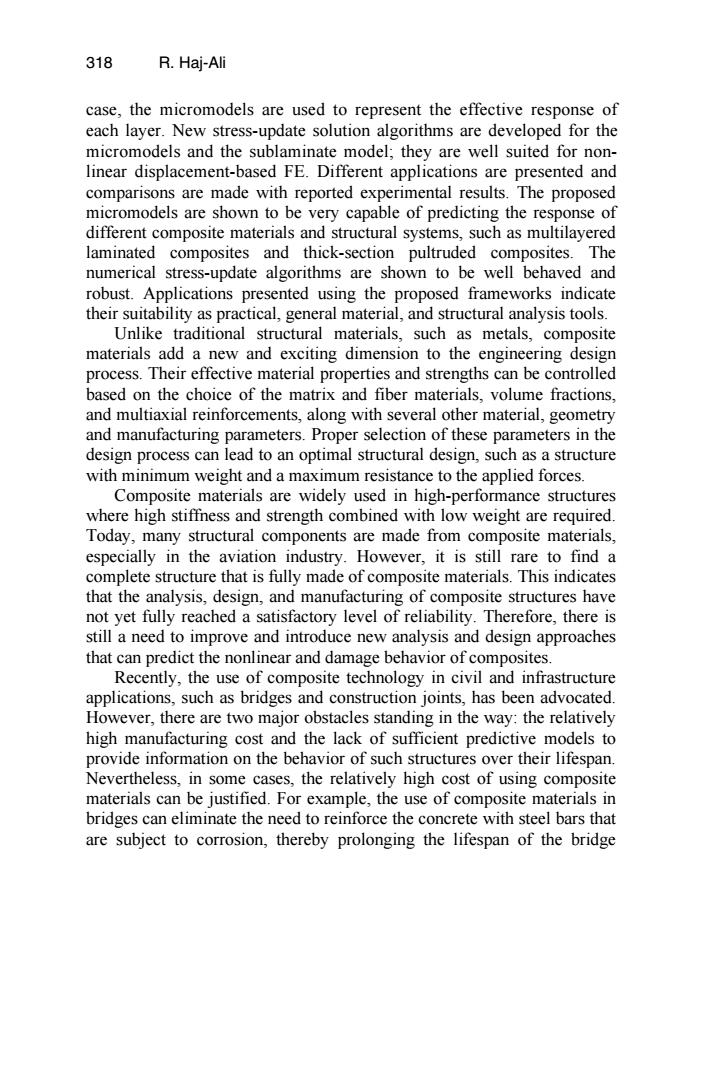正在加载图片...

318 R.Haj-Ali case,the micromodels are used to represent the effective response of each layer.New stress-update solution algorithms are developed for the micromodels and the sublaminate model;they are well suited for non- linear displacement-based FE.Different applications are presented and comparisons are made with reported experimental results.The proposed micromodels are shown to be very capable of predicting the response of different composite materials and structural systems,such as multilayered laminated composites and thick-section pultruded composites.The numerical stress-update algorithms are shown to be well behaved and robust.Applications presented using the proposed frameworks indicate their suitability as practical,general material,and structural analysis tools. Unlike traditional structural materials,such as metals,composite materials add a new and exciting dimension to the engineering design process.Their effective material properties and strengths can be controlled based on the choice of the matrix and fiber materials,volume fractions, and multiaxial reinforcements,along with several other material,geometry and manufacturing parameters.Proper selection of these parameters in the design process can lead to an optimal structural design,such as a structure with minimum weight and a maximum resistance to the applied forces. Composite materials are widely used in high-performance structures where high stiffness and strength combined with low weight are required. Today,many structural components are made from composite materials, especially in the aviation industry.However,it is still rare to find a complete structure that is fully made of composite materials.This indicates that the analysis,design,and manufacturing of composite structures have not yet fully reached a satisfactory level of reliability.Therefore,there is still a need to improve and introduce new analysis and design approaches that can predict the nonlinear and damage behavior of composites. Recently,the use of composite technology in civil and infrastructure applications,such as bridges and construction joints,has been advocated. However,there are two major obstacles standing in the way:the relatively high manufacturing cost and the lack of sufficient predictive models to provide information on the behavior of such structures over their lifespan. Nevertheless,in some cases,the relatively high cost of using composite materials can be justified.For example,the use of composite materials in bridges can eliminate the need to reinforce the concrete with steel bars that are subject to corrosion,thereby prolonging the lifespan of the bridgecomparisons are made with reported experimental results. The proposed micromodels are shown to be very capable of predicting the response of different composite materials and structural systems, such as multilayered laminated composites and thick-section pultruded composites. The numerical stress-update algorithms are shown to be well behaved and robust. Applications presented using the proposed frameworks indicate their suitability as practical, general material, and structural analysis tools. Unlike traditional structural materials, such as metals, composite materials add a new and exciting dimension to the engineering design process. Their effective material properties and strengths can be controlled based on the choice of the matrix and fiber materials, volume fractions, and multiaxial reinforcements, along with several other material, geometry and manufacturing parameters. Proper selection of these parameters in the design process can lead to an optimal structural design, such as a structure with minimum weight and a maximum resistance to the applied forces. Composite materials are widely used in high-performance structures where high stiffness and strength combined with low weight are required. Today, many structural components are made from composite materials, especially in the aviation industry. However, it is still rare to find a complete structure that is fully made of composite materials. This indicates that the analysis, design, and manufacturing of composite structures have not yet fully reached a satisfactory level of reliability. Therefore, there is still a need to improve and introduce new analysis and design approaches that can predict the nonlinear and damage behavior of composites. Recently, the use of composite technology in civil and infrastructure applications, such as bridges and construction joints, has been advocated. However, there are two major obstacles standing in the way: the relatively high manufacturing cost and the lack of sufficient predictive models to provide information on the behavior of such structures over their lifespan. Nevertheless, in some cases, the relatively high cost of using composite materials can be justified. For example, the use of composite materials in bridges can eliminate the need to reinforce the concrete with steel bars that are subject to corrosion, thereby prolonging the lifespan of the bridge R. Haj-Ali micromodels and the sublaminate model; they are well suited for nonlinear displacement-based FE. Different applications are presented and case, the micromodels are used to represent the effective response of each layer. New stress-update solution algorithms are developed for the 318